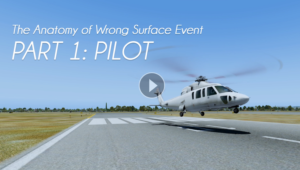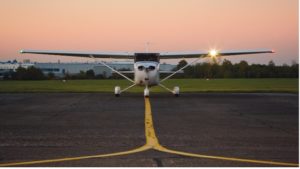The Anatomy of a Wrong Surface Event
Discernment Through Dissection
Follow
Feb 26 · 8 min read
By Nick DeLotell, FAA Aviation Safety Inspector

→ Right-click here and open a new tab/window to follow along with our companion animation.
As you roll out of the right turn from base to final, you’re lower and closer than normal. That was expected, and you grin as you remember how you love it when a plan comes together. You did a circling approach after all. You’re slightly inside a half-mile final.
Visually, you’re rolling out on the extended centerline and you note the Precision Approach Path Indicator (PAPI) on the left. You look for the runway numbers as you do a cursory glance down the runway, but your eyes move quickly back inside. Manifold pressure coming back to 18 inches, speed checks at 110 knots, final flaps now in transit, gear down and locked.
You begin focusing on the Touchdown Zone Markings as you cross over the airport fence. It’s been another great day; clear skies, calm winds, the smell of leather and avgas, and your baby has been purring like the 300 horsepower kitten she is. All you have to do is grease the landing. Ready … set …
That’s when you see it.

You’re about to rear-end a helicopter that’s hovering above the Touchdown Zone!
Your heart rate doubles. Your breathing stops. Your pupils dilate, and your grip tightens as your body instinctively reacts. Somehow, your brain manages to broadcast an SOS to your left arm that says, “Bank, don’t pitch!” Before you know it, you’re in a violent evasive right turn. You settle on a course that’s generally straight downfield between the parallel runways, beginning your actual go-around as you pass mid-field.
Possible pilot deviation, advise you contact tower at this phone number after you park …
You cleared the helicopter by about 50 feet. You intuitively kept it on your side of the airplane for visibility, but you narrowly missed the windsock as a result. Things like this tend to excite Air Traffic Controllers; as you regain your senses, you realize what they are trying to communicate to you.
You were cleared to land on the parallel runway, not the one in use by the helicopter. You finally land safely and check in with the ground controller. Hiding your emotions, you acknowledge the final transmission. “Possible pilot deviation, advise you contact tower at this phone number after you park …”
You’re no fledgling, so just how in the name of Wilbur could this have happened?
Gross Anatomy
The word anatomy is from the Greek ana temnein, meaning, “to cut up.” Just like in the medical connotation, we can dissect and study this event for the benefit of all. That’s exactly what we did when we published the Anatomy of a Wrong Surface Event animation series on the Runway Safety Pilot Simulator.
A trait we all share as humans is mortality. In facing that, some of us choose to donate our remains to science, or the aviation equivalent of sharing our flight information, in the interest of training future doctors or pilots. Thus we contribute to advances in medicine or aviation, and in making positive impacts on future generations. The FAA’s Compliance Program facilitates that sharing through an open, problem-solving approach that allows safety problems to be studied though an exchange of information. When you share safety-related information, we get better at identifying the things that threaten aviation safety.
When you share safety-related information, we get better at identifying the things that threaten aviation safety.
Let’s look at how we dissected this event, what we learned about it, and what it means to you.
The Human

The pilot in this case had been flying an average of 37 hours per year for the past 33 years. However over the past four years, the pilot had averaged about 15 hours per month, and even more so over the past 90 days. The private pilot was instrument current, was a certified pilot in other foreign countries, and had some glider hours logged as well. With a valid medical certificate, a good training record, and no history of violations, you’d be hard pressed to find a better example of a general aviation (GA) pilot.
How do you relate? Are you a “rustier” pilot, or perhaps less experienced? Are you a seasoned pro with more experience and qualifications? Would you be surprised if I told you that it didn’t matter?
It doesn’t matter.
The ego-busting trait we share as pilots is the fact that we’re all humans. Humans make mistakes, and given the right combination of variables, we’re all susceptible to the same traps and errors.
The Machine

The five-year-old aircraft in this scenario was a well-equipped, high-performance, complex, single-engine airplane. Like the pilot, it had a good maintenance record, no history of discrepancies, and you’d be hard pressed to find a better example of a GA aircraft.
Does it matter? Yes! Most runway incursions or other surface incidents like this wrong surface event (WSE) involve airplane single-engine land aircraft with less than 400 horsepower. Multi-engine and sea airplanes are still well represented, just to a much lesser extent.
What kind of aircraft will you be flying next?
The Setting
This event occurred mid-morning in visual meteorological conditions (VMC) conditions within busy Class D airspace. This matters too, because nearly all WSEs occur in daylight VMC conditions in Class C or Class D airspace. The trend clearly indicates (pun intended) that we humans have some visual acuity issues.
Few of us have had a close call. All of us are susceptible to the same traps and errors that can lead to them. It really could have been you.
So trust, but verify! Check out the article, “Safe and Sound on the Ground” in this issue to learn what you can use inside the cockpit to verify what you see outside of it.
An EFB APP-roach to Improving Surface Safety
The Sequence
We encourage you to refer to the Runway Safety Pilot Simulator animation Anatomy of a Wrong Surface Event; Episode 1 to see how this event played out.
Following the completion of a practice RNAV (GPS) approach to Runway 28L, the pilot was instructed to circle south of the airport making right-hand traffic for Runway 10R. The Air Traffic Control Tower (ATCT) was also working with a helicopter in left-hand closed traffic on Runway 10L.
Due to the hangar location, the pilot requested Runway 10L. The ATCT replied, “Have your request,” but then cleared the pilot to land as planned on Runway 10R.
The rest is history.
Eureka
The word eureka, from the Greek heurēka, means “I have found it.” Picking up where we left off, you secure your airplane and then call the ATCT in response to the “possible pilot deviation,” aka the Brasher Notice. The purpose of the Brasher Notice is not to give angry controllers the opportunity to scold pilots. The intent is to give you an opportunity to make note of the event and to collect your thoughts in preparation for a conversation with a Flight Standards Service inspector.
The conversation with Flight Standards is all about information sharing and analyzing the many factors that contributed to the event. That’s where the Compliance Program really begins, and where you first recognize the FAA’s evolution towards a “just culture.” During the conversation, you and the inspector review the Air Traffic Control audio of the event and retrace every detail of the flight. There is consideration of honest mistakes, and a very positive interaction. You’re relieved to find yourself speaking with another mere human, one who can totally relate to your experience!
In this case, the investigation reveals several contributing factors.
🛩️ Unusually complex airspace that forced you to modify the circling approach. The airspace offers limited space for base and final approach legs.
🛩️ Loss of situational awareness when you failed to recognize several radio transmissions that should have alerted you to the presence of the helicopter operating on the parallel runway.
🛩️ Expectation bias when you requested the more convenient runway (10L), but never mentally acknowledged that you were cleared to land on the parallel (10R).
You’re reminded that ATCT phrases like “roger” and “on request” are not approvals or clearances.
Eureka!

For the Benefit of All
The Compliance Program is all about accountability and correction, not blame and punishment. Based on the results of the investigation, you and the FAA took the following actions:
✔ You voluntarily submitted a detailed NASA Aviation Safety Reporting System (ASRS) report.
✔ You voluntarily completed several applicable online courses via the FAA Safety Team (FAASTeam).
✔ You agreed to participate in a Remedial Training Program with the FAA, where you accomplished a flight review with the local designated pilot examiner.
✔ You maintained your spotless pilot record.
✔ The FAA published a Notice of Proposed Rule Making (NPRM), which proposed changes to the local airspace that provide additional protections for circling.
✔ The FAA created several outreach products that bring awareness to the common factors associated with wrong surface events.
Reprinted with permission from FAA Safety Briefing. Visit the Flight Safety Briefing website: https://www.faa.gov/news/safety_briefing/



